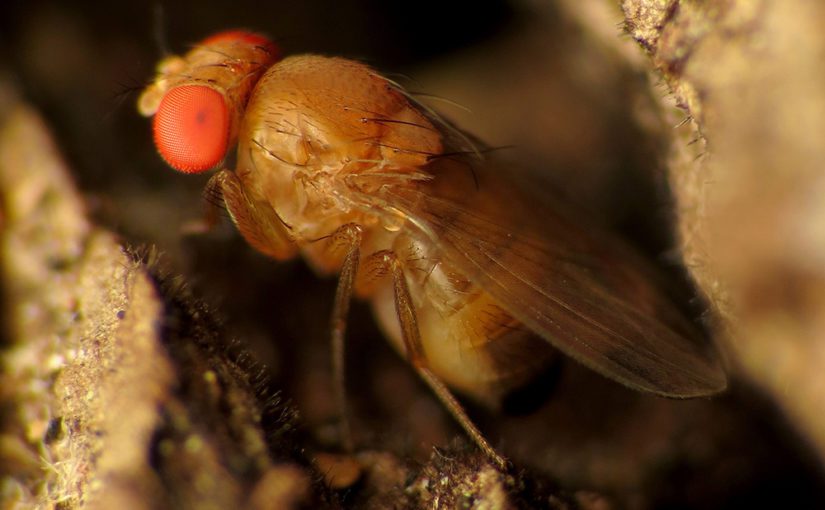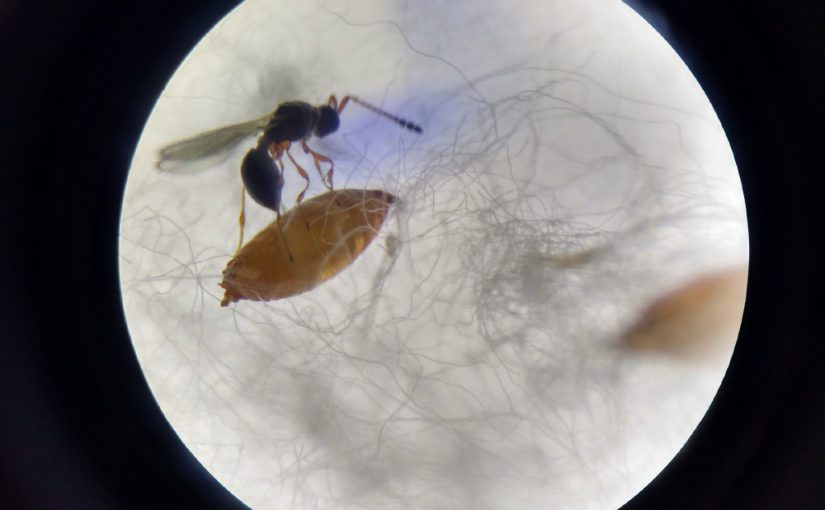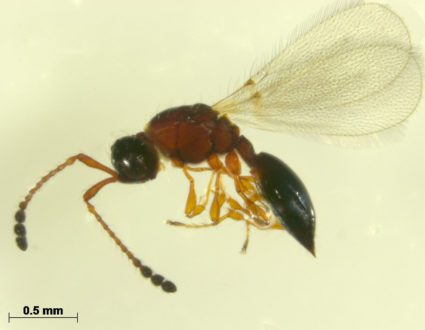Mar 18, 2019Study aims to protect parasitoids of spotted wing drosophila
Spotted-wing drosophila (Drosophila suzukii) is a fruit fly that originated in Asia and became an invasive species in North America, South America, and Europe.The fly lays its eggs in small fruits such as cherries, blueberries, and strawberries, causing $500 million to $700 million dollars in crop damage in the U.S. each year.
However, species of other insects called parasitoids lay their eggs in spotted-wing drosophila eggs and pupae, and these parasitoids help with natural biological control of D. suzukii in the environment. Insecticides used to control spotted-wing drosophila that show lower toxicity to these parasitoids are preferable because they don’t impede the ability of the parasitoids to contribute to management of the pest.
To explore the insecticide resistance of parasitoid species, Daniele Cristine Hoffmann Schlesener, Ph.D., Flávio Roberto Mello Garcia, Ph.D., and colleagues at the Federal University of Pelotas in Brazil investigated how two parasitoid wasps, Trichopria anastrephae and Pachycrepoideus vindemmiae, are affected by eight common commercial insecticides used to control fruit pests. The results fo their study were published last week in the Journal of Economic Entomology.
Spotted-wing drosophila are difficult to control because they develop quickly and they eat many different types of fruits, allowing them to survive in a range of habitats. This study focused on two parasitoids of spotted-wing drosophila: T. anastrephae, a parasitoid of the South American fruit fly Anastrepha fraterculus, and P. vindemmiae, a parasitoid of the Mexican fruit fly (Anastrepha ludens). The Mexican fruit fly is a serious pest of fruit in Mexico and Central America, and P. vindemmiae is used for biological control of that species.
Knowledge is limited on the degree to which insecticides affect the survival and parasitization capability of parasitoids of spotted-wing drosophila. The aim of Schlesener’s study was to help fill this gap. She studied the degree to which the two parasitoids were affected by the following insecticides: abamectin, acetamiprid, deltamethrin, malathion, phosmet, spinetoram, spinosad, and thiamethoxam.
The parasitoids were collected from blackberry plants in Pelotas County, Brazil, and maintained in glass vials in the lab. To test for lethal effects of insecticides on the parasitoids, parasitoids in glass vials were exposed for four hours to one of the insecticides or a control of distilled water. Parasitoids were then removed from the vials and were monitored from 1 hour to 120 hours following exposure.


For the parasitoid T. anastrephae, abamectin, spinetoram, and spinosad caused nosignificant increase in mortality; acetamiprid caused moderate mortality; deltamethrin caused 90 percent mortality; and thiamethoxam, phosmet, and malathioncaused100 percent mortality. For the parasitoid P. vindemmiae, all insecticides caused significant increases in mortality. In all the treatments, the amount of time to reach 10 percent mortality (often signified via the abbreviation LT10), and the amount of time to reach 50 percent mortality (LT50), was longer in T. anastrephae than in P. vindemmiae.
To test for effects of insecticides on parasitization, adults of the two parasitoids species were exposed to insecticides residues for four hours. After this period, the parasitoids were moved to clean glass vials, and pupae of D. suzukii were offered for parasitism for 24 hours. The research team then measured the degree of parasitism of the spotted-wing drosophila pupae and the emergence rates of the parasitoids.
In this experiment, T. anastrephae showed no significantly decreased parasitism when treated with abamectin, spinetoram, or spinosad, but showed no parasitism at all when exposed toacetamiprid, malathion, phosmet, or deltamethrin. P. vindemmiaes howed decreased parasitism after exposure to every one of the insecticides.
In summary, Schlesener and colleagues discovered that, after insecticide exposure, P. vindemmiae was more susceptible to insecticides, with higher mortality rates over shorter time periods, than T. anastrephae. P. vindemmiae also showed significantly less parasitism behavior after being exposed to insecticides. The authors proposed that this might be because of P. vindemmiae‘s smaller body size. Therefore, T. anastrephae would be expected to contribute more to biological control in the presence of the insecticides studied.
“The most important finding of our study,” Schlesener says, “was our discovery that some insecticides can be used together with parasitoids, conserving the natural enemies of spotted-wing drosophila that occur naturally in the field.” For T. anastrephae, abamectin, spinetoram, and spinosad caused no increase in mortality, and for P. vindemmiae abamectin caused a low increase in mortality. Therefore, all else being equal, abamectin, spinetoram, and spinosad would be the preferred insecticides because they would be expected to cause less damage to parasitoids of spotted-wing drosophila than other insecticides available for management of spotted-wing drosophila.


What do the results of this study mean for potential biological control strategies? Schlesener says, “I believe that the two parasitoid species studied in this research are not promising for applied biological control, since they are generalists. However, they do play a significant role in the natural biological control of the pest, so their conservation is critical.”
Looking to the future, Schlesener says, “I believe the biggest challenge for the biological control of Drosophila suzukii is to find a natural enemy that is a specialist on spotted-wing drosophila and that can increase the efficiency of parasitism by overcoming the physiological barriers presented byD. suzukii, such as the high number of hemocyte defense cells present in this species. Our efforts are focused on this aspect.”
The results of this study have wide applicability because the insecticides investigated are widely used not only in Brazil but also in Europe and the United States. Also, the ecological implications of insecticides on parasitoids extend beyond mortality. Sublethal effects, Schlesener and colleagues explain, can impair the parasitoid’s ability to serve important ecosystem-function roles such as parasitism. For example, this study found that abamectin and spinetoram showed low effects on mortality in T. anastrephae, but these insecticides significantly reduced T. anastrephae life spans. Further research will continue to elucidate the complex interactions among control agents and biological control species to help inform optimization of integrated pest management strategies.
– John P. Roche, Ph.D., Journal of Economic Entomology
Photo at top: Trichopria anastrephae is a wasp parasitoid of the invasive fruit fly spotted-wing drosophila, (Drosophila suzukii), a serious pest of fruit crops. A new study shows that some insecticides are less damaging to the survival and parasitism abilities of parasitoids of spotted-wing drosophila. The use of these lower-toxicity insecticides could help conserve these parasitoids that provide natural biological control of this invasive pest species. Photo: Daniele Cristine Hoffmann Schlesener, Ph.D.















